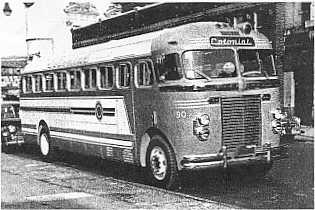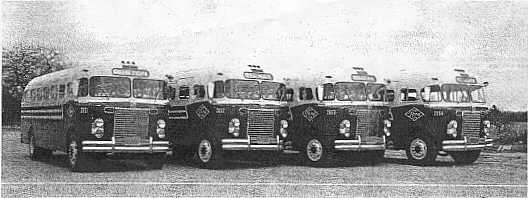
| The Super Power Duraliner was FitzJohn's last attempt to make a front-engine bus. Mode1 635 was introduced in 1949 as a replacement for the large Falcon. It had all the features of its more expensive competitors, but just 25 were sold. Colonial Bus Service of Brooklyn operated one of them, a 40-passenger bus with nonreclining seats and New York State school lights. |
|
place of the 95-hp JXD and in being slightly longer {26'10" as against 26'8" for the standard 28-passenger version). Other modifications of the Duraliner with larger engines and more seats were sold until 1956 and represented some of FitzJohn's last production before the Roadrunner.
During 1947, FitzJohn followed a general trend by equipping its popular Cityliner with standee windows. The basic body structure was not altered, and as a result the standee windows were extremely narrow. By this time too, the Cityliner was available in several sizes; there was a 27 or 29-passenger version and one with 37 or 39 seats, as well as the standard 33 or 35-passenger model.
The Falcon was discontinued in 1946, and in its place as the most powerful FitzJohn over-the-road model eventually appeared the Super Duraliner. Like the Falcon, this 36-passenger bus had a Waukesha 140-GK motor that developed 176 hp. It was 33'5t" long. Known as model 635, the Super Duraliner (or Super Power Duraliner, as the ads had it) was not a conspicuous success. Only a single production run of 25 coaches was completed, in 1949; some of these were not sold until 1953. .
-------------------------------------------------------------------
One of several heavier versions of the 28-passenger Duraliner was the model 525. Six of the seven 525's were sold to MacKenzie Coach Lines (Boston-Halifax); when MacKenzie was broken up in 1951, these buses went to Maine Central Transportation Co.

17